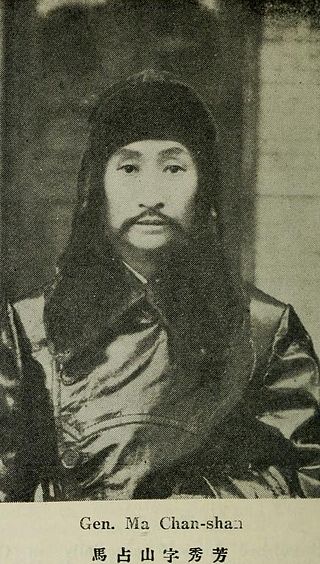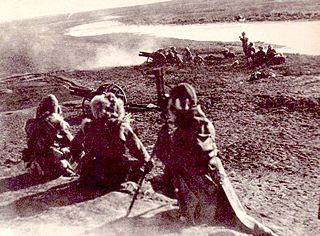
The Second Sino-Japanese War, also known as the Second China–Japan War and the Chinese War of Resistance against Japanese Aggression, was fought between the Republic of China and the Empire of Japan from 1937 to 1945, as part of World War II. This total war between China and the Empire of Japan is often regarded as the beginning of World War II in Asia, although some scholars consider the European War and the Pacific War to be entirely separate, albeit concurrent. It was the largest Asian war in the 20th century and has been described as "the Asian Holocaust", in reference to the scale of Imperial Japan's war crimes against Chinese civilians. After the Japanese attacks on Malaya and Pearl Harbor in 1941, the war merged with other conflicts which are generally categorized under the China Burma India Theater of World War II by the Western allies.
A resistance movement is an organized group of people that tries to resist the government or an occupying power, causing disruption and unrest in civil order and stability. Such a movement may seek to achieve its goals through either the use of nonviolent resistance, or the use of force, whether armed or unarmed. In many cases, as for example in the United States during the American Revolution, or in Norway in the Second World War, a resistance movement may employ both violent and non-violent methods, usually operating under different organizations and acting in different phases or geographical areas within a country.

The defense of the Great Wall was a campaign between the armies of Republic of China and Empire of Japan, which took place before the Second Sino-Japanese War officially commenced in 1937 and after the Japanese invasion of Manchuria in 1931. It is known in Japanese as Operation Nekka and in many English sources as the First Battle of Hopei.

The Battle of Rehe was the second part of Operation Nekka, a campaign by which the Empire of Japan successfully captured the Inner Mongolian province of Rehe from the Chinese warlord Zhang Xueliang and annexed it to the new state of Manchukuo. The battle was fought from February 21 to March 1, 1933.

The Manchukuo Imperial Army was the ground force of the military of the Manchukuo, a puppet state established by Imperial Japan in Manchuria, a region of northeastern China. The force was primarily used for fighting against Communist and Nationalist guerrillas in Manchukuo but also took part in battle against the Soviet Red Army on several occasions. It initially consisted of former National Revolutionary Army troops of the "Young Marshal" Zhang Xueliang who were recruited after the Japanese invasion of Manchuria en masse, but eventually expanded to include new volunteers and conscripts. The Imperial Army increased in size from about 111,000 troops in 1933 to an estimated strength of between 170,000 and 220,000 soldiers at its peak in 1945, being composed of Han Chinese, Manchus, Mongols, Koreans, Japanese, and White Russians. Throughout its existence the majority of its troops were considered to be mostly unreliable by their Japanese officers and advisers, due to poor training and low morale.

Ma Zhanshan was a Chinese general famous for resisting the Japanese invasion of Manchuria. Ma was placed in charge of the Northeastern Army in Heilongjiang Province during the invasion and ignored orders from the central government not to resist the Japanese. He became a national hero in China by fighting the unsuccessful but highly symbolic Jiangqiao campaign against the Kwantung Army's advance into Heilongjiang. After his defeat, he feigned defection to the Japanese and was appointed Minister of War in the new Japanese puppet state of Manchukuo. He then joined and took command of the guerrilla campaign against Japanese occupation, taking with him large amounts of supplies, funds, and military intelligence. Ma Zhanshan rejoined the Northeastern Army after the guerilla movement was largely defeated. He continued to oppose Chiang Kai-shek's policy of non-resistance and supported the Xi'an Incident that forced Chiang to form the Second United Front with the Chinese Communist Party (CCP). He commanded several units in the National Revolutionary Army during the Second Sino-Japanese War while covertly cooperating with the CCP. Ma avoided direct participation in the postwar Chinese Civil War and eventually defected to the Communists, dying a year later in 1950.

The Jinzhou Operation or Chinchow Operation was an operation in 1931 during the Japanese invasion of Manchuria, which was a preliminary, contributing factor to the outbreak of the Second Sino-Japanese War in 1937.

The Pacification of Manchukuo was a Japanese counterinsurgency campaign to suppress any armed resistance to the newly established puppet state of Manchukuo from various anti-Japanese volunteer armies in occupied Manchuria and later the Communist Northeast Anti-Japanese United Army. The operations were carried out by the Imperial Japanese Kwantung Army and the collaborationist forces of the Manchukuo government from March 1932 until 1942, and resulted in a Japanese victory.

Tang Juwu, Tang Chu-wu, 唐聚五,(20 April 1898 – 18 May 1939), Chinese officer, general of one of the Anti-Japanese Volunteer Armies resisting the pacification of Manchukuo.

Feng Zhanhai, or Feng Chan-hai, was one of the leaders of the volunteer armies resisting the Japanese and the puppet state of Manchukuo in northeast China. Feng was born on November 6, 1899. At eighteen he joined the Dongbei Army, and later entered a military school graduating in 1921. After he graduated, he was successively a platoon leader, company commander, and battalion commander. At the time of the Mukden Incident and Japanese invasion of northeast China he was a colonel commanding a regiment of the Jilin Guards Division.
Wang Fengge was born in Tonghua, Jilin, China. In 1914 Wang Fengge graduated from the Donghua Normal School, and had studied traditional martial arts as a young man. In 1922 he was made a company commander in a brigade of the Northeast Army. In 1926 he retired from the army, going into business, and became involved in the Big Swords Society.

The Northeast Anti-Japanese United Army was the main anti-Japanese guerrilla army in Northeast China (Manchuria) after the Japanese invasion of Manchuria in 1931. Its predecessors were various anti-Japanese volunteer armies organized by locals and the Manchuria branches of the Chinese Communist Party (CCP). In February 1936, the CCP, in accordance with the instructions of the Communist International, issued The Declaration of the Unified Organization of Northeast Anti-Japanese United Army and marked the official formation of the organization.

Yang Jingyu, born Ma Shangde, was a Chinese communist, military commander and political commissar who led the First Route Army of the Northeast Anti-Japanese United Army during the Second Sino-Japanese War. His troops waged a guerrilla war against Japanese forces in Manchukuo (Manchuria) who were attempting to suppress resistance in the region.

Li Zhaolin 李兆麟 (1910-1946), known earlier as Li Chaolan 李超兰, was the founder and leader of the 3rd Route Army, a division of the Northeast Anti-Japanese United Army in the Second Sino-Japanese War.
The Northeast People's Anti-Japanese Volunteer Army was led by Tang Juwu, formerly the commander of a Northeastern infantry regiment, interned by the Japanese at the beginning of the invasion of Manchuria. It was created by the Northeast National Salvation Society that had appointed Tang as commander following his escape from the Japanese, and helped him link with the local forces which others were organising. Tang also made use of his personal contacts with police chiefs, officials, local gentry militias and the leaders of the Big Swords Society. Tang was able to organize a force which threatened the region to the east of Mukden and communications with Korea.

Northeastern Volunteer Righteous and Brave Fighters was established by Wang Fengge, an officer in the Chinese Northeast Army who involved in the Big Swords Society. After the Japanese invasion of Northeast China in 1931, he raised an anti-Japanese force by linking up with other citizens in the Linjiang and Ji'an areas during late 1931. In March 1932, he announced the establishment of his army – the Northeastern Volunteer Righteous and Brave Fighters.
The Inner Mongolian campaign in the period from 1933 to 1936 were part of the ongoing invasion of northern China by the Empire of Japan prior to the official start of hostilities in the Second Sino-Japanese War. In 1931, the invasion of Manchuria secured the creation of the puppet state of Manchukuo and in 1933, Operation Nekka detached the province of Rehe from the Republic of China. Blocked from further advance south by the Tanggu Truce, the Imperial Japanese Army turned its attention west, towards the Inner Mongolian provinces of Chahar and Suiyuan, with the goal of establishing a northern China buffer state. In order to avoid overt violation of the Truce, the Japanese government used proxy armies in these campaigns while Chinese resistance was at first only provided by Anti-Japanese resistance movement forces in Chahar. The former included in the Inner Mongolian Army, the Manchukuo Imperial Army, and the Grand Han Righteous Army. Chinese government forces were overtly hostile to the anti-Japanese resistance and resisted Japanese aggression only in Suiyuan in 1936.
Wu Yicheng one of Wang Delins companions who had been with him for many years as a bandit, was made one of Wang's company commanders along with Kong Xianrong, when Wang was taken into the Kirin Provincial army and became a battalion commander. Wang Delin refused to submit to the Japanese during the invasion of Manchuria in 1931 and formed the Chinese People's National Salvation Army, Wu became a subordinate leader of one of the largest and most successful of the volunteer armies.
Li Yanlu, 李延禄, (1895–1985), soldier, communist, and leader of anti-Japanese forces in Manchuria. Li was born in Yenchi, Kirin Province, in April 1895. He became involved in the opposition to Yuan Shikai's attempt to restore the monarchy. He joined the Fengtian Army in 1917, as a private soldier and rose to platoon leader, then captain over the next sixteen years. Politically, he moved to the left and in July 1931, he joined the Communist Party of China. Three months later, the Japanese began the Mukden Incident and invasion of Manchuria. Avoiding capture and internment by the Japanese, he joined the volunteer army of Wang Delin. There, Communists were welcomed and Li and Zhou Baozhong were made high-ranking officers. Li became the chief of staff of Wang's Chinese People's National Salvation Army, one of the most successful of the volunteer armies resisting the Japanese and its puppet state of Manchukuo. He was also said to have been secretly organizing communists within the army. Yet Party policy at the time opposed the volunteer armies and the participation of members in them and had their own Northeastern People's Revolutionary Army. At first, the Party severely criticised their conduct yet the stance of the Party prevented the growth of their own forces and did not help the anti-Japanese cause.
Following the defeat of the forces of Ding Chao at Harbin in February 1932, Feng Zhanhai withdrew his forces to Shanhetun, a village in the Wuchang District. He then called for volunteers, and the Public Safety Bureaus in the local districts turned over to them their police and militia, and established Feng as the General in command of a force, the Northeastern Loyal and Brave Army, of 15,000 men in the hills with the capital of Jilin City to his south and the metropolis of Harbin to his north. There he was able to wreak havoc on the Japanese rail communications on the Chinese Eastern Railway running through his area of control.












